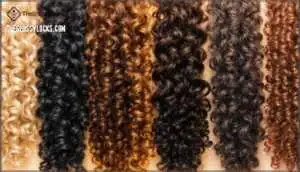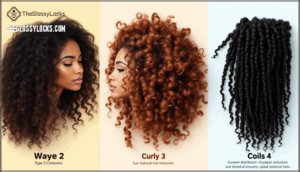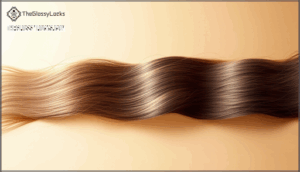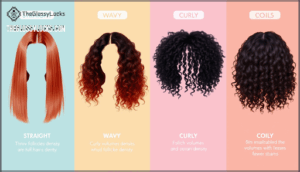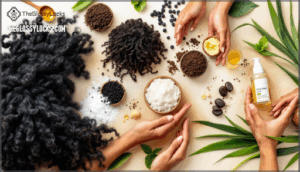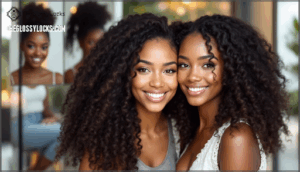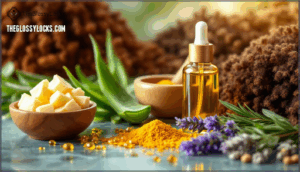This site is supported by our readers. We may earn a commission, at no cost to you, if you purchase through links.
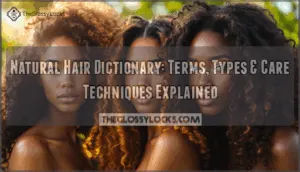
Over 60% of Black women wear natural hair today, yet many still feel lost understanding the vocabulary—from curl patterns to co-washing to protective styling. The difference between a twist out and a braid out matters. Knowing your hair density changes everything.
This natural hair dictionary breaks down the essential terms, hair types, and care methods you need to understand your hair’s unique personality and take control of your journey.
Table Of Contents
- Key Takeaways
- Key Terms in The Natural Hair Dictionary
- Hair Types, Textures, and Patterns
- Essential Hair Care Techniques and Methods
- Popular Styling and Maintenance Terms
- Common Ingredients and Product Terminology
- Frequently Asked Questions (FAQs)
- What is natural hairstyling?
- What is another word for natural hair?
- What does it mean to go natural with your hair?
- Is natural hair a thing?
- What are the different types of natural hairstyles?
- What is your natural hair type?
- What products work best for low porosity hair?
- How do I know my hair porosity level?
- What causes hair breakage and how to prevent it?
- Should I use heat styling tools on natural hair?
- Conclusion
Key Takeaways
- Natural hair is a complete system of textures, techniques, and terminology—not just avoiding relaxers—and mastering this language lets you build a personalized regimen that actually works for your hair’s unique needs.
- Your hair type (determined by curl pattern and strand characteristics using the Andre Walker classification) directly shapes which products and care methods will deliver results, making proper identification essential for preventing breakage and maximizing growth.
- Combining protective techniques like deep conditioning, protein treatments, and low-manipulation styling reduces breakage by 30–50% while boosting moisture retention by 15–60%, creating the foundation for measurable length retention and healthier strands.
- The natural hair movement reflects real economic and social shifts—the market hit $10.85 billion in 2025 with over 60% of Black women wearing natural hair today—meaning you’re joining a thriving community backed by expanding product accessibility and evolving beauty standards that prioritize choice over rigid definitions.
Key Terms in The Natural Hair Dictionary
The natural hair world has its own language. Before you can build a solid routine or understand product labels, you need to know what terms like growing out your hair or "big chop" actually mean.
Here are the foundational concepts that will help you navigate your hair journey with confidence.
Natural Hair and Going Natural
Natural hair means your texture remains unaltered by relaxers, texturizers, or perms. Going natural reflects a movement toward hair health, cultural identity, and freedom from chemical health risks. This natural hair journey embraces authenticity while the natural hair dictionary clarifies key hair terminology. Understand the basics:
- Over 60% of Black women now wear natural hair consistently
- Product accessibility has expanded dramatically across retailers by 2025
- Evolving standards now prioritize choice over rigid definitions
The natural hair movement shows that natural hair thrives as a popular option. Hair conversion challenges vary, but the community offers support throughout your natural hair journey.
Transitioning and Big Chop
Switching to natural hair involves discontinuing the use of relaxers and allowing your true hair texture to grow in. This process typically spans 6–12 months for about 28% of people, although some may need up to 2 years. The demarcation line—where relaxed and natural hair meet—creates a texture contrast and increases the risk of breakage. Around 41.9% of individuals report neutral feelings during this phase, often facing social resistance and an identity shift. The Big Chop (BC), which involves cutting off processed ends after months of growth, can have a significant emotional impact and lead to renewed confidence. Deep conditioning often helps keep hair moisturized and prevents dryness.
| Phase of Switching | Timeline |
|---|---|
| Visible curl pattern | 3–4 months |
| Common BC timing | 6–12 months |
| Full adjustment | Up to 2 years |
Over 67% of people feel happy post-switch, often replacing 70–80% of their hair products. The Natural Hair Dictionary defines these milestones as foundational to your hair switch experience.
Hair Journey and Regimen
Once you’ve made the big chop, your hair journey begins—a custom path marked by regimen consistency and learning what works for your unique texture. Establishing a natural regimen takes time, usually 18–24 months, but this journey empowerment builds confidence and self-reliance.
Your hair care regimen evolves as you navigate shifting challenges like product overload and discover the importance of seasonal adjustments. The Natural Hair Dictionary defines your hair journey as more than routine—it’s your roadmap to mastery and natural hair terminology fluency.
The Natural Hair Community
You’re not walking this path alone. The natural hair community spans over 21.8 million Instagram posts, digital influence from licensed stylists, and community events like NaturalHairFest 2025 that celebrate cultural pride and challenge texture discrimination.
This Natural Hair Dictionary connects you to a movement demanding retail equity, safer hair care formulations, and authentic representation—where every hair texture matters and natural hair terminology becomes your shared language of belonging.
Hair Types, Textures, and Patterns
Your hair is as unique as your fingerprint. The natural hair community uses a classification system to help you identify your specific texture and choose the right products and techniques.
Here’s how to decode your hair type and understand what makes your curls tick.
Hair Type Classification (1-4, A-C)
You might know the Andre Walker Hair Type Classification System even if you’ve never heard the name. This framework organizes hair texture into four main types: Type 1 (straight), Type 2 (wavy), Type 3 (curly), and Type 4 (kinky-coily). Each type splits into subcategories A through C based on curl pattern tightness.
Type 4C hair shows the most dramatic shrinkage at up to 75% when dry. The system shapes market trends and helps you find products that actually work for your texture.
Curl Patterns (Waves, Curls, Coils)
Curl patterns categorize hair texture into waves (Type 2), curls (Type 3), and coils (Type 4). Each curl pattern reflects unique structure geometry defined by hair cortex asymmetry. Wavy hair forms loose S-shapes, while curly hair creates defined ringlets. Coily hair exhibits tight zigzag patterns with curl diameters under 0.4 mm.
Global distribution varies widely—coily patterns dominate in sub-Saharan populations, while wavy types prevail across European regions. Biological influences like humidity and hormones affect curl tightness and elasticity.
Hair Strand Size (Fine, Medium, Coarse)
Hair strand size determines how thick or thin individual strands measure and affects everything from breakage and size to thermal styling effects. Understanding hair diameter variation helps you choose products that work with your texture, not against it.
Here’s what strand size means for your hair:
- Fine strands (50–60 µm) break easier and get weighed down fast—skip heavy oils and reach for lightweight leave-ins that won’t flatten your volume product impact.
- Medium strands give you flexibility with most formulas, balancing hair elasticity and resilience without extreme sensitivity to product buildup.
- Coarse strands (100–120 µm) resist damage better but need richer moisturizers to penetrate the cortex and maintain hair porosity balance.
- Strand size genetics vary widely across populations—knowing your baseline helps you predict how your hair reacts to heat, color, and styling stress.
Hair Density and Volume
Hair density counts the actual follicles per square centimeter on your scalp—averaging 120 to 200 hairs/cm² across populations—while hair volume measures the physical space your hair occupies. Ethnic density variations matter: Caucasian hair averages 220 hairs/cm², Afro-textured hair around 150 hairs/cm², and Asian hair sits near 170 hairs/cm².
Density measurement techniques reveal that coily hair creates impressive volume despite lower follicle counts because curl patterns trap more air.
Growth and shedding cycles naturally shed 50 to 100 hairs daily, and restoring hair density requires follicular intervention, whereas boosting volume comes down to styling smart.
Essential Hair Care Techniques and Methods
Knowing the right techniques can transform your hair care routine from guesswork into a science. The methods below address moisture retention, hair strength, and damage prevention.
Each technique has a specific purpose in building a healthy foundation for natural hair.
Co-Wash and Pre-Poo
You’re dealing with two essential wash techniques here. CoWash, or conditioner-only washing, uses gentle surfactants to cleanse without stripping oils—reducing cuticle damage by up to 30% compared to sulfate shampoos. PrePoo treatments apply oils or conditioners before washing to shield your hair from hydration stress and prevent mechanical breakage. Think of these methods as your defense against:
- Surfactant buildup that leads to scalp occlusion
- Lipid retention loss from harsh detergents
- Weakened strands from repeated swelling and shrinking
Combining both can boost smoothness by 60% while protecting your natural moisture barrier.
Deep Conditioning and Protein Treatments
These two techniques address your hair’s structural integrity and hydration needs. Deep conditioning restores moisture and elasticity by saturating strands with conditioning agents, boosting retention by 60% and cutting breakage in half when done weekly for 20-30 minutes on damp hair. Protein treatments infuse hydrolyzed proteins to reinforce your hair’s molecular structure, reducing breakage by 50% and increasing strand diameter.
Balance is critical: alternate moisture and protein every 4-6 weeks to avoid rigidity from protein overload. Check your hair’s flexibility before reapplication to maintain the best moisture balance and prevent damage repair setbacks.
Treatment frequency and ingredient synergy determine your results—protein overload causes brittleness, while proper hair treatment sequencing maximizes both strength and suppleness.
| Treatment Type | Primary Benefit | Recommended Frequency |
|---|---|---|
| Deep Conditioning | Hydration & elasticity boost | Weekly (20-30 min) |
| Protein Treatments | Structural reinforcement | Every 4-6 weeks |
| Hydrolyzed Protein | Fine hair maintenance | As needed for damage repair |
| Keratin Formulas | Severe damage recovery | Based on porosity assessment |
| Balanced Rotation | Prevents protein sensitivity in hair | Alternate treatments consistently |
Baggying, Plopping, and Accordion Method
Now that you’ve locked in moisture and strength through deep conditioning and protein treatments, these three styling techniques work together to seal in those gains. Baggying traps moisture by 30% using a plastic cap, boosting hair growth retention to 0.5–1 inch monthly and elasticity by 15–25% within three months. Plopping cuts drying time by 20–35% while reducing frizz by 40–50%, preserving curl definition for up to 12 hours post-wash. The Accordion Method compresses curls vertically, improving definition consistency by 60% and maintaining curl integrity for 48 hours.
Match your styling goals to your hair type: baggying suits coarse, high-porosity strands; plopping benefits mid-porosity curls; accordion styling excels for low-porosity hair seeking volume without buildup.
Combine techniques for layered results—plopping followed by accordion styling yields 35% enhancement in moisture and shape retention across the board.
Trims and Length Retention
Now that you’ve sealed in moisture and strength, trimming becomes your secret weapon for keeping what you’ve built.
Here’s the reality: split ends travel upward along your hair shaft if you ignore them, erasing growth gains despite healthy root activity. Trim every 8–12 weeks to prevent 25–35% of potential strand loss annually. Watch for frizzy ends, reduced elasticity, or single-strand knots—these signal it’s time.
Regular trims preserve shaft integrity and improve moisture distribution, maintaining visible length over extended cycles while reducing breakage by up to 30%.
Popular Styling and Maintenance Terms
Once you understand your hair type and master the foundational care techniques, it’s time to explore how you actually style and maintain your natural hair.
The methods ahead show you how to create definition, protect your curls, and keep manipulation to a minimum—so your hair can thrive without constant handling.
Twist Outs and Braid Outs
Twist outs and braid outs are foundational natural hair styling techniques that showcase your curl pattern while protecting your strands. Twist outs use two strands twisted together to create looser curls and volume, while braid outs use three strands for defined waves and up to 2–4 inches of elongation.
Braid outs retain moisture 15–30% better and last 3–7 days compared to twist outs’ 2–5 days. Choose twist outs for high definition on 4A–4B hair, or braid outs for 4B–4C textures seeking length display and shrinkage reduction.
Both are low-manipulation styles supporting hair health and length retention.
Protective Styles (Weaves, Wigs, Braids)
While twist outs and braid outs let your natural curl pattern shine, protective styles like weaves, wigs, and braids take a different approach. They shield your hair from daily stress and environmental damage by minimizing handling.
Box braids, cornrows, and Senegalese twists reduce breakage by 30–40% while improving moisture retention up to 25%. Modern material innovation—from lace front construction to breathable wig caps—aids scalp health during wear.
Style longevity ranges from weeks to months depending on installation methods and maintenance. These styles honor cultural heritage while giving your strands the rest they need to thrive.
Low Manipulation Styling
Between protective styles and daily handling, low manipulation styling finds the sweet spot. You’re reducing touch frequency without fully tucking hair away—think twist-outs, braid-outs, and wash-and-gos that last 5–14 days.
Here’s why it works:
- Breakage drops 30–40% when you handle hair fewer than three times weekly versus traditional daily styling.
- Moisture stays put as your natural sebum distributes undisturbed, boosting shine and elasticity.
- Scalp stays accessible so you can maintain health while still giving strands the rest they need.
The approach appeals to 67% of natural hair wearers seeking easier maintenance and real length retention. You’re not waiting weeks for a protective style to come down—you’re working with your texture instead of against it.
Detangling and Stretching
Detangling and stretching work together to fight breakage and reveal your hair’s true length. Wet detangling with conditioner reduces strand stress by 28% compared to dry methods. Start from the ends and work upward using a wide-tooth comb or fingers—this prevents knots from tightening.
For Type 4 hair, tension techniques like banding or African threading create up to 50% elongation retention. Consistent stretching after washing reduces tangle density by 40% while distributing natural oils evenly.
Smart tool selection matters too: semi-flexible brushes lower breakage by 20–30% versus stiff bristles. These practices keep your hair elastic, healthy, and growing.
Common Ingredients and Product Terminology
When you’re building your natural hair regimen, knowing what’s actually in your products makes all the difference. The ingredients you choose determine how your hair reacts to moisture, strength, and growth.
Let’s break down the key components you’ll encounter as you navigate product labels and formulations.
Carrier Oils (Castor, Coconut, Olive)
Carrier oils are your hair’s best defense against damage. Coconut, castor, and olive oils contain fatty acids that penetrate the hair shaft and reduce protein loss.
Coconut oil forms a barrier that locks in moisture and improves tensile strength. Castor oil’s high viscosity retains hydration and promotes scalp health through its antiviral properties. Olive oil works as an emollient with anti-inflammatory effects.
These oils account for significant market expansion as the natural hair care industry grows. Choose based on your hair’s needs and porosity levels.
Humectants and Silicones
Humectants and silicones work differently but both serve your hair’s hydration needs. Humectants like glycerin and panthenol draw moisture from the air into your hair shaft through hydrogen bonding. They’re especially powerful for curly and coily hair that loses moisture quickly.
Silicones form a protective film that locks moisture in and reduces friction for smoother strands. However, silicones can build up over time and require clarifying shampoos for removal.
The industry is shifting toward plant-based humectants and eco-friendly silicone alternatives that deliver results without environmental persistence. Choose based on your hair porosity and whether you prioritize natural ingredients or product efficacy.
Sulfates and Hair Product Build-Up
Sulfates like sodium lauryl sulfate strip up to 72% of your scalp’s natural oils in a single wash. Found in over 90% of mainstream shampoos, they’re effective cleansers but leave your hair dry and brittle over time.
People with curly or color-treated hair face a 60% higher risk of frizz and scalp irritation. Build-up from waxy ingredients clogs follicles and causes shedding.
Break the cycle by alternating sulfate-free shampoos with clarifying shampoos every one to two weeks. Amino acid-based alternatives reduce protein loss by 40% while protecting your scalp health.
Hair Growth Supplements (e.g., Nature’s Bounty Hair Skin Nails)
Your hair growth journey doesn’t start at the salon—it starts with what you’re putting in your body. Hair growth supplements like Nature’s Bounty Hair Skin Nails combine biotin, vitamins, and minerals that support follicle strength and scalp health. The global market reached $830.6 million in 2024 and is projected to hit $1.9 billion by 2030. While clinical evidence on biotin alone remains mixed, studies show a 15% increase in strand count when supplements pair with balanced nutrition. Consumers aged 25–44 drive 60% of purchases, especially through e-commerce platforms.
Here’s what matters:
- Biotin is the primary ingredient in most formulas, though efficacy depends on whether you’re deficient to begin with
- Multivitamin blends containing zinc and iron show better results than single-ingredient supplements for post-hair loss recovery
- Collagen-based supplements gain 12% annual growth as consumers seek improved elasticity and thickness
- Asia Pacific dominates 35% of global revenue due to rising awareness and disposable income
- Over 55% of new 2024 launches underwent independent lab testing, signaling stronger ingredient research standards
Frequently Asked Questions (FAQs)
What is natural hairstyling?
Natural hairstyling means rejecting chemical relaxers and embracing your hair’s authentic texture.
It’s about self-expression, cultural identity, and committing to hair health through specialized care techniques specific to your unique curl pattern.
What is another word for natural hair?
In the natural hair community, you’ll hear several terms used interchangeably with natural hair. Raw hair, unprocessed hair, and untreated hair all describe hair that hasn’t undergone chemical processing. Authentic hair emphasizes its genuine, unaltered state. Some use crude or organic to highlight chemical-free qualities. These terms reflect the movement toward embracing your hair’s true texture and identity.
What does it mean to go natural with your hair?
Going natural means ditching chemical treatments and embracing your hair’s authentic texture. You’re choosing to let your curls, coils, or waves exist without relaxers, perms, or heat damage.
It’s about hair freedom—reclaiming your natural hair care routine while celebrating cultural identity and self-acceptance through your authentic texture.
Is natural hair a thing?
Like a seed breaking through concrete, natural hair represents reclaiming your authentic identity. Yes—it’s profoundly real.
Natural hair represents reclaiming your authentic identity—it’s profoundly real and reshaping beauty standards worldwide
The global natural hair care market reached USD 85 billion in 2025 and continues growing. What started as cultural resistance during the Civil Rights Movement has transformed into a thriving movement.
You’re witnessing genuine economic, legal, and social shifts challenging beauty standards worldwide.
What are the different types of natural hairstyles?
You’ve got several options depending on what works for your lifestyle. Twist-outs and braid-outs give you defined curls in 2-4 hours. Two-strand twists balance versatility with hair health benefits.
Protective styles like box braids last weeks and reduce breakage. Locs take time to mature but offer long-term protection.
Afros and puffs celebrate your natural texture with minimal styling.
What is your natural hair type?
Your hair type depends on your curl pattern and strand characteristics. The Andre Walker system classifies hair into four types: straight (Type 1), wavy (Type 2), curly (Type 3), and coily or kinky (Type 4). Each type has subcategories A through C. Your genetic curl patterns determine where you fall.
Take a hair type quiz or examine your natural curl pattern to identify yours. Understanding your hair texture and types helps you choose the right care routine for your specific needs.
What products work best for low porosity hair?
Your low porosity hair resists water like a sealed envelope. Water beads on the surface instead of soaking in. You need lightweight ingredients and water-based conditioners that penetrate easily.
Humectants like glycerin and honey draw moisture in. Argan oil and hydrolyzed proteins work better than heavy oils.
Use clarifying shampoos to prevent product buildup that blocks hydration. Styling gels with humectants define curls while maintaining elasticity without weighing hair down.
How do I know my hair porosity level?
The float test shows your hair’s buoyancy in water—floating means low porosity, sinking means high. Observe drying time: quick drying suggests low porosity while slow drying indicates high. Product absorption rate and humidity response also reveal porosity levels.
The strand test reveals texture differences through touch.
These practical indicators help you understand your hair cuticle’s moisture retention ability.
What causes hair breakage and how to prevent it?
Breakage stems from multiple sources. Mechanical stress during detangling weakens your hair shaft. Chemical treatments and heat above 140°C cause structural damage. Moisture imbalance and nutritional deficiencies like biotin and zinc create brittleness.
Prevention works through protective styling, gentle detangling, deep conditioning, and maintaining elasticity via hydration and proper nutrition.
Should I use heat styling tools on natural hair?
You can use heat styling tools on natural hair, but proceed with caution. Heat damage risks include keratin breakdown starting around 300°F, cuticle cracking, and permanent loss of curl pattern. Protective measures like heat protectants reduce damage but won’t eliminate it entirely.
Non-heat alternatives—twist outs, braid outs, heatless curlers—preserve elasticity and strength. If you do use heat, limit it to once weekly or less.
Recovery timelines vary: moderately damaged hair may improve in 2-3 months with protective treatments, though full restoration takes longer. The safest approach? Skip heat styling most days and embrace styling tools that don’t require it.
Conclusion
Your natural hair dictionary is your passport to mastery. Understanding curl patterns, hair density, and care techniques isn’t just vocabulary—it’s reclaiming authority over your texture.
Every term you learn becomes a tool. Every method you master becomes a strategy.
This natural hair dictionary gives you the language to decode what your hair needs and the confidence to deliver it. Your crown demands fluency.
- https://www.thebusinessresearchcompany.com/market-insights/natural-hair-care-products-market-overview-2025
- https://www.globenewswire.com/news-release/2025/01/21/3012402/0/en/Growth-Trends-in-the-Natural-Hair-Care-Products-Industry-2025-2030.html
- https://www.grandviewresearch.com/horizon/outlook/natural-hair-care-product-market/united-states
- https://www.earthtonesnaturals.com/blogs/all-about-your-hair/17167004-hair-typing-systems
- https://fulhamscalphairclinic.com/news/the-silent-battle-heat-and-chemical-damage-to-afro-hair/

